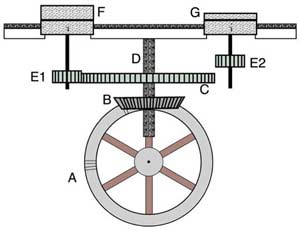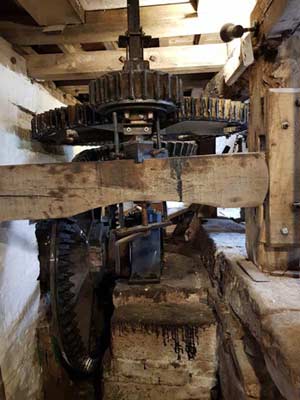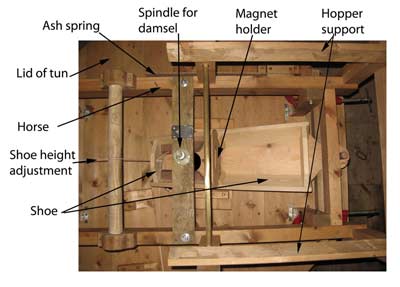The Mill Machinery
Millstones are always in pairs – a lower or "bedstone", which was fixed, and an upper "runner" which rotated. Our mill has four pairs of millstones in line: two stones were driven by each waterwheel. The upper set of machinery is essentially complete while some of the lower set was removed when the wheel was adapted to provide power to the local gypsum mine.
The pitwheel, (A) is on the same shaft as the waterwheel and turns the wallower (B) on the upright shaft (D). The great spur wheel, (C) is also on this upright shaft and it is from this that the stones are driven by means of stone nuts. In the diagram the left-hand stone nut (E1) is in mesh while the right-hand one (E2) has been lifted clear. The miller could engage or disengage each stone to allow him full control of the stones.
The left-hand stones, (F) are French Burr while the right-hand pair, (G) are gritstones and were used for shelling - removing the hard husk from the oats. The French Burr stones are the ones we still use for grinding wheat. The other two pairs of stones, on the lower machinery, are both local gritstone and would have been used for milling oats or animal feed.
The milling process is illustrated in the diagram above. The French Burr stones (F) are enclosed in a wooden case or "tun" (H) to catch the meal and keep out the insects and vermin who would otherwise be very interested. On top of this case is a frame called the horse (J) holding the hopper of grain (K). The grain falls from this hopper into and along the sloping "shoe" (L) which is shaken by a cam called the "damsel" (M), to keep the grain moving until it falls into eye of the upper millstone, or runner stone, which is spinning round. The lower stone, or bedstone, is stationary.
As the grain flows towards the edge of the millstones it is ground into flour. The tun prevents the flour flowing everywhere and a brush connected to the runner stone sweeps it down the chute (N) into a sack or bin below. Unfortunately, it is not possible to see the stones which produce the flour, as any window into the stone case would be obscured by flour dust within minutes! There is, however, a window into the tun surrounding the upper pair of oat shelling stones
There is other machinery on this lower floor of the mill. The gearing in front of the right-hand machinery drove a shaft which was supported by the bearing in the opposite wall. There were probably pulleys on this shaft to provide a belt drive to power auxiliary machinery. It is not known what auxiliary machinery was actually used at Acorn Bank, but it often included a bolter or winnower which completed the task of removing husks from the oats, and a dresser which sieved flour into different grades.
To the left of the room is a wooden box suspended from the ceiling. This is the jigger-box, also known as a jog-scry or oatmeal shaker. The last name hints at its use; to sieve and grade oatmeal. It was driven from the 4th pair of stones by a system of belts and pulleys. There are also some heavy stone slabs in the floor on the immediate left of the door as you enter the building which probably supported another piece of machinery. It has been suggested that this might have been a pearl barley machine, though these were less commonly found in Cumbria than in north east England.




